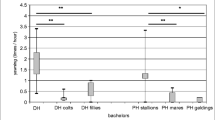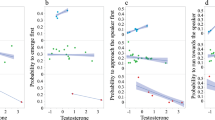Abstract
In collective movements, some individuals are more effective and attractive leaders than others. Parameters such as social network, personality, and physiologic needs failed to explain why group members follow one leader more than another. In this study in the domestic horse, we propose to focus on the leader’s attitude and its impact to the followers’ recruitment during two conditions: spontaneous group departures or experimentally induced departures. We postulate that the expressiveness of the leader could enhance its attractiveness and thus produce a successful followership. We found that a high expressiveness level is associated with a high curiosity score and with a low social status. This propensity to initiate while being expressive was higher in the experimental condition than in the spontaneous condition which was expected, since the experimental procedure sought to increase the motivation of initiators with a highly appetent reward. Moreover, the more intense the leader’s expressiveness is, the faster the followers will join the movement regardless of the condition. This positive and dynamic attitude can be perceived as an attractive feature by the followers. Finally, we evidenced collective arousal in followers initiated by the leader that could be essential for group cohesion. The present study is the first to investigate the expressiveness level in animals, and provides new insights into the emergence of leadership.




Similar content being viewed by others
References
Altmann J (1974) Observational study of behavior: sampling methods. Behaviour 49:227–266
Anne O, Rasa E (1983) Dwarf mongoose and hornbill mutualism in the Taru desert, Kenya. Behav Ecol Sociobiol 12:181–190
Bates D, Maechler M, Bolker B, Walker S, Christensen RHB, Singmann H, Dai B, Grothendieck G, Green P, Bolker MB (2016) Package “lme4,” in: R Package Version 1.1-10
Berger J (1977) Organizational systems and dominance in feral horses in the Grand Canyon. Behav Ecol Sociobiol 2:131–146
Black JM (1988) Preflight signalling in swans: a mechanism for group cohesion and flock formation. Ethology 79:143–157
Bono JE, Ilies R (2006) Charisma, positive emotions and mood contagion. Leadersh Q 17:317–334
Bono JE, Judge TA (2004) Personality and transformational and transactional leadership: a meta-analysis. J Appl Psychol 89:901–910
Bourjade M, Thierry B, Maumy M, Petit O (2009) Decision-making in Przewalski Horses (Equus ferus przewalskii) is driven by the ecological contexts of collective movements. Ethology 115:321–330
Bourjade M, Thierry B, Hausberger M, Petit O (2015) Is leadership a reliable concept in animals? An empirical study in the horse. PLoS ONE 10:e0126344
Bouton ME (2016) Learning and behavior: a contemporary synthesis, 2nd edn. Sinauer Associates Inc, Publishers, Sunderland
Briard L, Dorn C, Petit O (2015) Personality and affinities play a key role in the organisation of collective movements in a group of domestic horses. Ethology 121:888–902
Briard L, Deneubourg J-L, Petit O (2017) How stallions influence the dynamic of collective movements in two groups of domestic horses, from departure to arrival. Behav Process 142:56–63
Camazine S, Bonabeau E, Théraulaz G, Deneubourg J-L, Sneyd J, Franks NR (2001) Self-organization in biological systems. Princeton University Press, Princeton, p 538
Conradt L, Roper TJ (2003) Group decision-making in animals. Nature 421:155–158
Conradt L, Roper TJ (2005) Consensus decision making in animals. Trends Ecol Evol 20:449–456
Corbin M, Bouvet G, Briard L, Petit O (2019) Collective behavior in horses: do physiological needs determine movement initiation? Ecology and Behavior meeting, Toulouse, p 84
David HA (1987) Ranking from unbalanced paired-comparison data. Biometrika 74:432–436
De Marco A, Cozzolino R, Dessì-Fulgheri F, Thierry B (2011) Collective arousal when reuniting after temporary separation in Tonkean macaques. Am J Phys Anthropol 146:457–464
Ducoing AM, Thierry B (2003) Withholding information in semifree-ranging Tonkean macaques (Macaca tonkeana). J Comp Psychol 117:67–75
Feist JD, McCullough DR (1976) Behavior patterns and communication in feral horses. Z Für Tierpsychol 41:337–371
Fischhoff IR, Sundaresan SR, Cordingley J, Larkin HM, Sellier M-J, Rubenstein DI (2007) Social relationships and reproductive state influence leadership roles in movements of plains zebra, Equus burchellii. Anim Behav 73:825–831
Fox J, Weisberg S (2011) An R companion to applied regression, 2nd edn. Sage, Thousand Oaks
Jacobs A, Sueur C, Deneubourg JL, Petit O (2011) Social network influences decision making during collective movements in Brown Lemurs (Eulemur fulvus fulvus). Int J Primatol 32:721–736
Johnstone RA (1996) Multiple displays in animal communication: ‘Backup Signals’ and ‘Multiple Messages’. Philos Trans R Soc B Biol Sci 351:329–338
Krueger K, Heinze J (2008) Horse sense: social status of horses (Equus caballus) affects their likelihood of copying other horses’ behavior. Anim Cogn 11:431–439
Krueger K, Flauger B, Farmer K, Hemelrijk C (2014) Movement initiation in groups of feral horses. Behav Processes 103:91–101
Lansade L, Philippon P, Hervé L, Vidament M (2016) Development of personality tests to use in the field, stable over time and across situations, and linked to horses’ show jumping performance. Appl Anim Behav Sci 176:43–51
Lê S, Josse J, Husson F et al (2008) FactoMineR: an R package for multivariate analysis. J Stat Softw 25:1–18
Maechler M (2013) Cluster analysis extended Rousseeuw et al. R Package. http://cran.r-project.org/web/packages/cluster/cluster.pdf
McComb K, Moss C, Durant SM, Baker L, Sayialel S (2001) Matriarchs as repositories of social knowledge in African elephants. Science 292:491–494
McGreevy P, McLean A (2010) Equitation science. Wiley, Oxford
Mech LD (1970) The wolf: the ecology and behavior of an endangered species. Univeristy of Minnesota Press, Minneapolis, p 416
Meunier H, Deneubourg J-L, Petit O (2008) How many for dinner? Recruitment and monitoring by glances in capuchins. Primates 49:26–31
Petit O, Bon R (2010) Decision-making processes: the case of collective movements. Behav Process 84:635–647
Pinheiro J, Bates D (2017) Linear and nonlinear mixed effects models
Ramos A, Petit O, Longour P, Pasquaretta C, Sueur C (2015) Collective decision making during group movements in European bison, Bison bonasus. Anim Behav 109:149–160
Ramseyer A, Petit O, Thierry B (2009a) Decision-making in group departures of female domestic geese. Behaviour 146:351–371
Ramseyer A, Thierry B, Boissy A, Dumont B (2009b) Decision-making processes in group departures of cattle. Ethology 115:948–957
Schweitzer C, Gaillard T, Guerbois C, Fritz H, Petit O (2017) Participant profiling and pattern of crop-foraging in Chacma Baboons (Papio hamadryas ursinus) in Zimbabwe: why does investigating age-sex classes matter? Int J Primatol 38:207–223
Sueur C (2011) Group decision-making in chacma baboons: leadership, order and communication during movement. BMC Ecol 11:26
Sueur C, Petit O (2008a) Organization of group members at departure is driven by social structure in Macaca. Int J Primatol 29:1085–1098
Sueur C, Petit O (2008b) Shared or unshared consensus decision in macaques? Behav Processes 78:84–92
Sueur C, Petit O, Deneubourg JL (2009) Selective mimetism at departure in collective movements of Macaca tonkeana: an experimental and theoretical approach. Anim Behav 78:1087–1095
Walter F, Bruch H (2009) An affective events model of charismatic leadership behavior: a review, theoretical integration, and research Agenda. J Manag 35:1428–1452
Watts DP (2000) Mountain gorilla habitat use strategies and group moup movements. In: Boinski S, Garber PA (eds) On the move: how and why animals travel in groups. University of Chicago Press, Chicago, pp 352–374
Whitehead H (2009) SOCPROG programs: analysing animal social structures. Behav Ecol Sociobiol 63:765–778
Acknowledgements
We warmly thank Thierry Bourgeois, Nans Burgarella, Rose Delacroix, Océane Liehrmann, Luc Martin, Virginie Nierat, Edouard Paumier, Louise Prévost, Julie Renard, Pierre Uhlrich, Lucile Villot for helping with the experimental task and Rachel Annan for proofreading the revised version of the manuscript. A USIAS Grant awarded to O.P. funded the overall project.
Author information
Authors and Affiliations
Corresponding author
Ethics declarations
Ethical approval
All the experiments undertaken in this study complied with ethical standards of French research practices. The authorization number is AL/01/10/07/11 for the Regional Ethical Comity for Animal Experimentation (CREMEAS). Neither procedure adversely affected the horses in the short term or for the overall period of the study.
Additional information
Publisher's Note
Springer Nature remains neutral with regard to jurisdictional claims in published maps and institutional affiliations.
Electronic supplementary material
Below is the link to the electronic supplementary material.
Rights and permissions
About this article
Cite this article
Gérard, C., Valenchon, M., Poulin, N. et al. How does the expressiveness of leaders affect followership in domestic horses (Equus ferus caballus)?. Anim Cogn 23, 559–569 (2020). https://doi.org/10.1007/s10071-020-01361-8
Received:
Revised:
Accepted:
Published:
Issue Date:
DOI: https://doi.org/10.1007/s10071-020-01361-8




